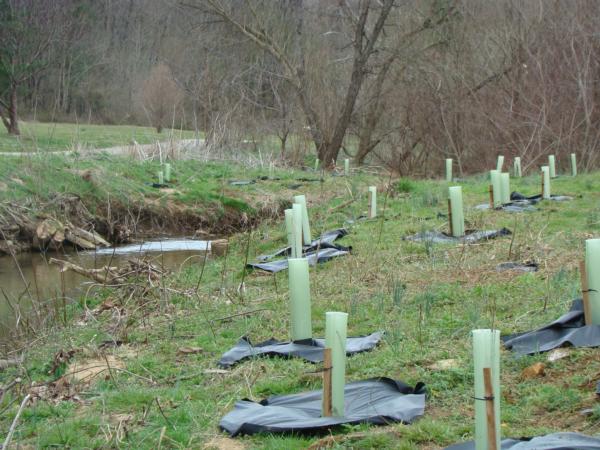Maintaining and monitoring bluebird nest boxes in partnership with the Virginia Bluebird Society is an extremely popular project for Virginia Master Naturalist volunteers all over the state. Over the years, VMN volunteers have contributed more than 13,000 volunteer hours to bluebird monitoring. The following article, written by Clark Walter, provides a little insight into what drives the passion for this project. Clark is a Certified Virginia Master Naturalist (Rivanna Chapter), a member of the Virginia Bluebird Society, and a member of the North American Bluebird Society. He was selected this past Fall as the 2015 Volunteer of the Year by the Virginia Bluebird Society. Please feel free to e-mail Clark at captainbreck@comcast.net if you have a question or want to place an order for his October 2016 nest box building session.
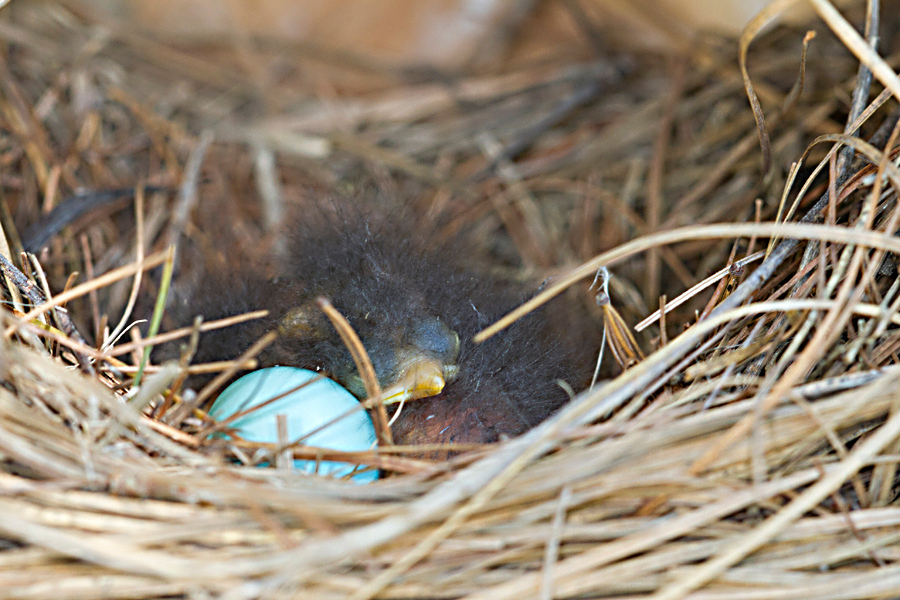
Baby bluebird in a nest box. Image by VMN-Historic Rivers Chapter
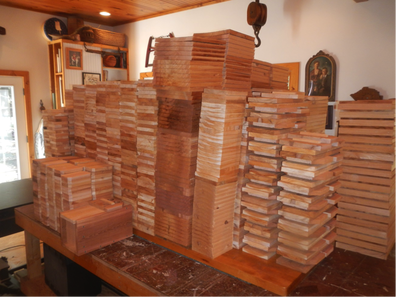 Clark Walter’s bluebird box building workshop.
Clark Walter’s bluebird box building workshop.
I became a Virginia Master Naturalist to learn about and get involved with natural Virginia. My mostly non-profit career was largely devoted to working for zoological institutions. I helped build national and international collaborations of coordinated species survival and reintroduction programs for mostly exotic and/or endangered species. In the process I built a working knowledge about the flora and fauna of Africa, Asia and South America. By contrast, living in the natural beauty that is Charlottesville, Virginia I knew relatively little about the flora and fauna in my own back yard. As a member of the Virginia Master Naturalist class of 2012 I was looking for an opportunity to learn more and to get actively involved as a Citizen Scientist on a local level. I had no idea what that might entail and where that might lead. Little did I know that I was about to embark on a great bluebird adventure.
One of our earliest class sessions was devoted to presenters from various organizations describing volunteer opportunities. One of those presenters was Ann Dunn, Virginia Master Naturalist and County Coordinator for the Virginia Bluebird Society. Ann was seeking volunteers to monitor established trails in Albemarle County. I inquired about the possibility of establishing a trail in my neighborhood. Then and there the all-important first piece of my life-changing journey fell into place when she agreed to come to Ivy and assess the viability of our habitat for bluebirds. The second piece fell into place when she identified 10 suitable spots. Being a compulsive designer/builder with a well-equipped work shop, I volunteered to build and donate the 10 bluebird set ups. Ann provided me with the Virginia Bluebird Society recommended and approved “Carl Little” nest box design and formally approved “Owensfield Trail” as a designated Virginia Bluebird Society trail making me the trail monitor. It was then that the wheels of the universe turned and something that felt like destiny fell into place and put me squarely on the path leading to where it has presently led. I never could have imagined then in 2012 where that path would so quickly lead by 2016.
One side of my heritage is German. My grandfather was an inventor during the industrial age. He built and ran a steel forging plant to make the things he sold to General Motors, Frigidaire and, during WW II, the RAF for the British Spitfire. That means I am genetically predisposed to be incredibly organized. Thankfully the other side of my family introduces a French gene that keeps my German organizational obsession from becoming a crippling neurosis and actually transforms it into an art form. It is a fine line I walk between obsessive compulsive disorder and art. I like to think so anyway. That also means I like doing things on a big scale so if I’m going to be building 10 bluebird nest boxes anyway, I might as well do more.
Things started small when I offered to build bluebird set ups for my Master Naturalist classmates for the cost of materials. A few took me up on my offer and in early Spring 2012 I built my first 20 nest boxes with poles and baffle predator guards – 10 for me and 10 for them. When I delivered those 10 to the next Master Naturalist class session, bluebird nest box envy swept through the room. Everybody wanted some and I needed to build another 48 for class members and instructors. More orders trickled in and I ended my first year having built 91 bluebird nest boxes. I could hardly believe it and so close to 100! That seemed like a magical number to me and I hoped that I would have occasion to build at least 9 more in the coming years. Little did I know.
The following February in preparation for the 2013 nesting season I needed a few more boxes to expand my trail. Only two months removed from my last building session, I was anticipating little or no demand for more nest boxes. Nevertheless, I repeated the offer to my classmates and a few other local VMNs to build nest box setups for the cost of materials. I was truly surprised when the response was immediate and steady. As orders accumulated through the year I periodically mounted building sessions to meet demand. Orders totaled 170 nest boxes in 2013. Once again, most of those were going to Virginia Master Naturalists in the Charlottesville area to replace worn out boxes and to establish new bluebird trails. I passed the magic number of 100 nest boxes so fast I should have been ticketed for speeding in a building zone.
By February of 2014 my call for orders was being passed on to Virginia Master Naturalists and Virginia Bluebird Society members statewide and had crossed state lines to attract blue birders from Maryland, Pennsylvania, Georgia and Ohio. My call for orders was also reaching bird clubs, institutions and educational projects at schools including Rutgers University, Innis Free and Fredericksburg Academy. Individuals and groups were arriving in rental vans or with trailers to pick up 30 or more bluebird setups at a time. A group of Master Naturalists from Blacksburg made an all-day outing to pick up their large order, visit my shop, and tour Charlottesville. Others brought their grandchildren to visit the shop for a “hands on” bluebird box building session. I built 240 nest boxes that November (the single largest building session to date) and finished 2014 with 365 nest boxes built for the year. My original goal to build 100 nest boxes had long dropped out of sight and now I watched as 500 nest boxes built faded into the distance in my rearview mirror. Far ahead a new magic number was just visible on the horizon and I dared to dream. It would take years and years to get there… if only I could live long enough and stay healthy enou
gh.
From the beginning Ann Dunn made it clear that when building bluebird nest boxes I was to use the Virginia Bluebird Society recommended and approved “Carl Little” design. I had heard of the Peterson box and other famous birders with their names attached to box designs, but I was not aware of Carl Little. I decided to remain silent on that subject and nodded my head like I knew when in fact I did not know. From the beginning whenever people picked up their boxes I would dutifully explain they were getting the Carl Little design and they would nod their heads solemnly in what I assumed was reverential respect for the great birding man Carl Little lost to the ages. Yes, they seemed to know exactly who I was talking about and I was not yet ready to ask one of them to tell me. And so it went happily along for about 500 boxes until the fateful day when someone finally asked me “Who was Carl Little?” I was horrified… so I went with the truth. I admitted I didn’t know and that I imagined Carl to be a famous local birder who lived long, long ago and tramped around in the woods with the other famous Charlottesville naturalist and explorer Meriwether Lewis. Yes, I figured the great Carl Little was now long dead and gone, but never forgotten. A few days later there was a knock at my door. I answered it to a nice couple standing there and the man says to me, “Hi! I’m Carl Little.” My first reaction was to blurt out “You can’t be, you’re dead!” However, my ability to stay silent on things I don’t know about remained blessedly intact when I needed it most. About this time I began to see the light and realize that there was a connection between Carl Little and the lovely Ann Little standing next to him who, coincidentally at that time, just happened to be President of the Virginia Bluebird Society. With good reason they could have worried about me and that could have been the end of my blue birding days right then. However, they were kindly forgiving. Carl visited my shop, signed my “Carl Little” blueprints and positively made my blue birding year. I was twice honored – they had come to pick up 50 Carl Little boxes. Holy mackerel! That’s like Thomas Edison coming to me for a light bulb not to suggest that I would or could build light bulbs for the cost of materials. I would much prefer a visit from Carl Little anyway. Anybody can design and build a light bulb.
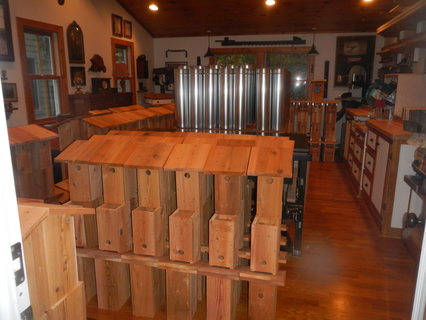 Bluebird boxes, stacked and ready to go!
Bluebird boxes, stacked and ready to go!
2015 was more of the same. More boxes to a wider audience coming from farther and farther away. The big new magic number barely visible in the distance not so long ago was barreling towards me at an alarming rate. This past October was my biggest one-time building session yet with 310 nest boxes plus 258 poles/baffle predator guards. I finished 2015 with 376 nest boxes built for the year and, in all the excitement, the big magic number slipped past me before I knew it. The grand total built since it all began with those 20 boxes in the Spring of 2012 is 1,002 nest boxes and 733 poles and baffle predator guards.
The past year has been a thrilling experience. Individuals and organizations came from every corner of Virginia to pick up boxes. Organizations taking large numbers of boxes in 2015 included the Monticello Owners Association, Monticello Bird Club, Loudon Wildlife Conservancy, Dorrier Park, Brambleton Community, Sunset Hills Winery, Pleasant Grove Trail, Brambleton Bluebird Club, Monticello High School, Fredericksburg Academy and the Augusta County Bird Club.
Managing the time, material costs, material needs, expenses and communications related to this project have evolved into a small not-for-profit enterprise. I need Excel spreadsheets to monitor pricing of parts, material lists, inventory, orders, and scheduling of pickups and deliveries. I have an account at a local builder supply to buy materials cheaper in quantity. On two occasions I have bought out the available supply of 1 x 6 cedar. This past Fall big trucks delivering large loads of lumber had the neighbors asking if we were putting on an addition. Fork lifts came down the driveway carrying 100 10’ metal conduits at a time. I tell inquiring minds that I am building a nuclear sub.
I’ve accumulated more than 750 hours of Virginia Master Naturalist volunteer service since 2012 including 240+ hours this past Fall. I also monitor Owensfield Trail for the Virginia Bluebird Society that has grown to 20 boxes fledging an average of 85 bluebirds per year over the last 4 nesting seasons. A wonderfully memorable moment was the first time I opened a box to see 5 baby bluebirds in the nest. I was so happy I wanted to pass out cigars and put balloons on our mail box.
I have organized the entire building process for mass production. Before a single nest box was assembled this past October all the pieces and parts for 310 boxes were cut, pre-drilled and stacked in sequential order ready for assembly. Material costs in 2015 were approximately $10,000. Material costs since 2012 exceed $22,000.
This experience has been and continues to be positively wonderful and rewarding. I watch the floor space of my shop disappear as it fills up with nest boxes ready for pickup until I can literally only just set foot inside the door. And then I watch it reappear as people pick up their boxes and take them away to the far corners of the state and beyond. It is positively thrilling to have all the Virginia Master Naturalists, Virginia Bluebird Society members, various institutions and other individuals from all over come to my shop to pick up their boxes and stay for a visit. They like the smell of the red cedar that hangs in the air. Word that I will build for the cost of materials for all comers has spread to people outside of Virginia Master Naturalists and Virginia Bluebird Society members to envelope organizations like Master Gardeners and Tree Stewards. It is inspiring to see all of these people get interested in blue birds. Two years ago people from adjoining neighborhoods who walk our street found me and got bluebird houses for their respective neighborhoods. Last year people walking in those neighborhoods tracked me down and got bluebird houses for their neighborhoods. And so it goes… spreading happiness on the wings of bluebird diplomacy.
I see no end in sight. October 2016 is already blocked off on the calendar for building blue bird nest boxes. Between now and then I will continue perfecting my predisposed German-French organizational skillset as an art form finding new ways to make boxes faster and cheaper.
Yes, this has gone far beyond what I ever dreamed. Early in my Virginia Master Naturalist training I wondered how I could ever accumulate the 40 hours of volunteer service a year required to remain certified. If someone had told me in February 2012 that I would one day volunteer 243.5 hours in one month as a Virginia Master Naturalist building blue bird nest boxes for the Virginia Bluebird Society and loving every minute…. Ha! No way!
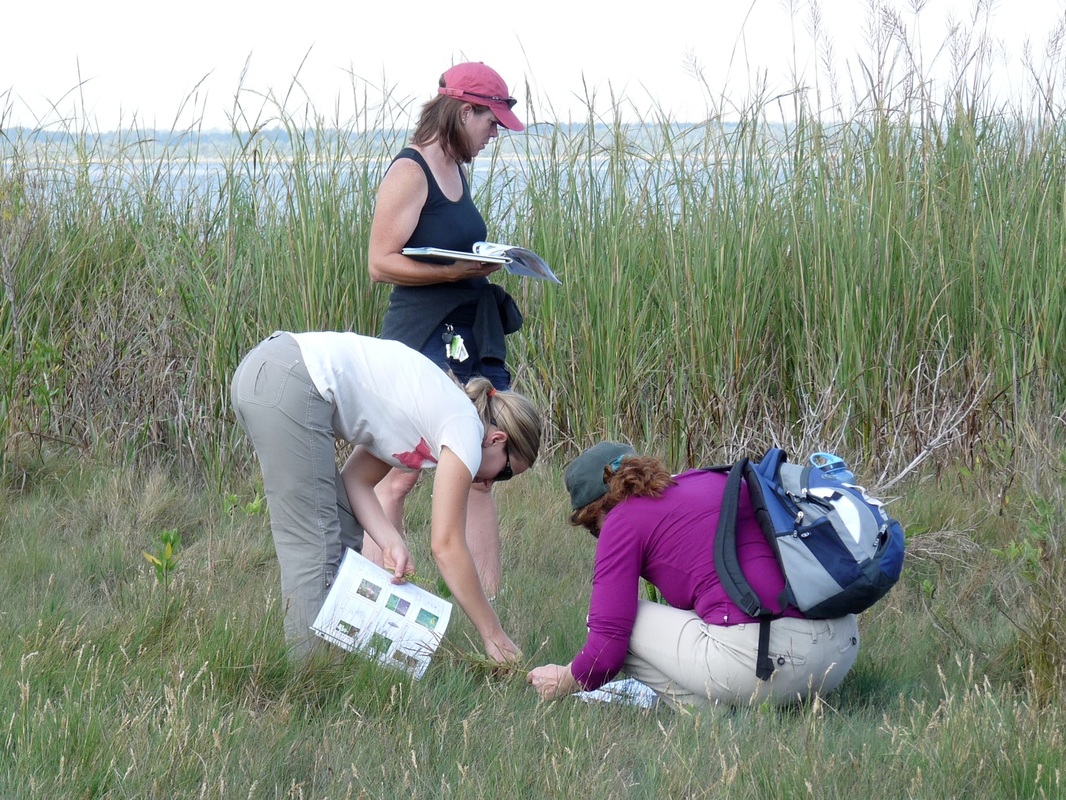 To become a VMN volunteer, individuals complete a basic training course with a local chapter. At least 25% of the course involves hands-on learning in the field. Photo by VMN-Historic Rivers Chapter.
To become a VMN volunteer, individuals complete a basic training course with a local chapter. At least 25% of the course involves hands-on learning in the field. Photo by VMN-Historic Rivers Chapter. 




